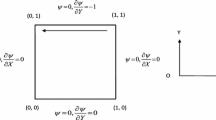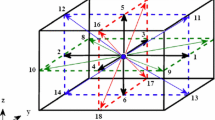Abstract
The Brinkman’s equation simplifies the numerical modeling of karst aquifers by allowing the use of a single transport equation to model the flow of fluids in both the free-flow and porous regions, in effect reducing the error arising from improper modeling of the interface between the two regions. Most equations available to model flow within karst aquifers deal with steady flow conditions. This may not be accurate in aquifers where unsteady conditions exist. We considered the effects of unsteady flow conditions in karst aquifers by assessing the addition of an unsteady flow term to the Brinkman’s equation. We solved the coupled mass conservation-transport equations that models unsteady fluid transport in karst aquifers and studied the effects of unsteady flow conditions on tracer transport in two different sample aquifers and compared to the results obtained from the steady flow Brinkman’s equation. The solution method adopted is sequential and it involves solving the unsteady Brinkman’s model first, followed by the advection-diffusion-adsorption equation using the cell-centered finite volume approach. The first example presented here is a simple aquifer model consisting of a single conduit surrounded by porous regions. The second example is a complicated structure consisting of complex geometrical caves embedded in a highly heterogeneous porous media. The results show that, inside the caves, the unsteady Brinkman’s model yielded lower tracer concentrations at early times when compared to the steady flow model. At longer times, both models produced almost similar results. In particular, the results obtained from the simplified example case (Example 1) indicate that the velocity profiles for unsteady flow within open conduits do not instantly yield a parabolic shape expected from the Brinkman’s equation, but gradually develops into one starting from a linear profile. Results obtained also show that the addition of unsteady flow term to the Brinkman’s model does not affect the flow of tracer within porous media in any significantly observable manner.













Similar content being viewed by others
References
Adler PM (1979) Motion and rupture of a porous sphere in a linear flow field. J Rheol (N Y N Y) 23:25–37. https://doi.org/10.1122/1.549514
Arbogast T, Brunson DS (2007) A Computatonal method for approximating a Darcy-Stokes system governing a vuggy porous media. Comput Geosci 11:207–218
Arbogast T, Lehr HL (2006) Homogenization of a Darcy-Stokes system modeling vuggy porous media. Comput Geosci 10:291–302. https://doi.org/10.1007/s10596-006-9024-8
Bauer S, Liedl R, Sauter M (2003) Modeling of karst aquifer genesis: influence of exchange flow. Water Resour Res 39:1285. https://doi.org/10.1029/2003WR002218
Beavers GS, Joseph DD (1967) Boundary conditions at a naturally permeable wall. J Fluid Mech 30:197. https://doi.org/10.1017/S0022112067001375
Beavers GS, Sparrow EM, Magnuson RA (1970) Experiments on coupled parallel flows in a channel and a bounding porous medium. J Basic Eng 92:843. https://doi.org/10.1115/1.3425155
Birk S, Liedl R, Sauter M, Teutsch G (2003) Hydraulic boundary conditions as a controlling factor in karst genesis: a numerical modeling study on artesian conduit development in gypsum. Water Resour Res 39:SBH 2-1–SBH 2-14. https://doi.org/10.1029/2002WR001308
Borghi A, Renard P, Cornaton F (2016) Can one identify karst conduit networks geometry and properties from hydraulic and tracer test data? Adv Water Resour 90:99–115. https://doi.org/10.1016/j.advwatres.2016.02.009
Brinkman HC (1949) A calculation of the viscous force exerted by a flowing fluid on a dense swarm of particles. Appl Sci Res 1:27–34. https://doi.org/10.1007/BF02120313
Cao Y, Gunzburger M, Hua F, Wang X (2010) Coupled Stokes-Darcy model with Beavers-Joseph interface boundary condition. Commun Math Sci 8:1–25. https://doi.org/10.4310/CMS.2010.v8.n1.a2
Chen Z (2007) Reservoir simulation: mathematical techniques in oil recovery. Society for Industrial and Applied Mathematics, Philadelphia
Dreybrodt W, Gabrovsek F (2010) A model of karstification in extended limestone plains by mixing corrosion. In: Andreo B, Carrasco F, Duran JJ (eds) Advances in research in karst media. Springer-Verlag, Berlin, pp 457–462
Durlofsky L, Brady JF (1987) Analysis of the Brinkman equation as a model for flow in porous media. Phys Fluids 30:3329–3341. https://doi.org/10.1063/1.866465
Field MS, Pinsky PF (2000) A two-region nonequilibrium model for solute transport in solution conduits in karstic aquifers. J Contam Hydrol 44:329–351. https://doi.org/10.1016/S0169-7722(00)00099-1
Gallegos JJ, Hu BX, Davis H (2013) Simulating flow in karst aquifers at laboratory and sub-regional scales using MODFLOW-CFP. Hydrogeol J 21:1749–1760. https://doi.org/10.1007/s10040-013-1046-4
Ghasemizadeh R, Yu X, Butscher C, Hellweger F, Padilla I, Alshawabkeh A (2015) Equivalent porous media (EPM) simulation of groundwater hydraulics and contaminant transport in karst aquifers. PLoS One 10:e0138954. https://doi.org/10.1371/journal.pone.0138954
Göppert N, Goldscheider N (2007) Solute and colloid transport in karst conduits under low- and high-flow conditions. Ground Water 46:61–68. https://doi.org/10.1111/j.1745-6584.2007.00373.x
He J, Killough JE, Fadlelmula F et al (2015) A unified finite difference model for the simulation of transient flow in naturally fractured carbonate Karst Reservoirs. Paper SPE-173262-MS. In: SPE Reservoir Simulation Symposium, 23–25 February. Society of Petroleum Engineers, Houston, Texas
Hill ME, Stewart MT, Martin A (2010) Evaluation of the MODFLOW-2005 conduit flow process. Ground Water 48:549–559. https://doi.org/10.1111/j.1745-6584.2009.00673.x
Huntoon PW (1999) Karstic permeability: organized flow pathways created by circulation. In: Karst modeling proceedings, special publication 5. Karst Waters Institute: Akron, pp 79–81
Jackson JA (1997) Glossary of geology. American Geological Institute, Virgina
Jamal MS, Awotunde AA (2018) Full-field to sector modeling for efficient flow simulation in karst aquifers. J Hydrol 564:682–696. https://doi.org/10.1016/J.JHYDROL.2018.07.028
Jamal MS, Awotunde A, Asad A (2018) Utilization of the Brinkman’s Equation to Model Flow and Tracer Transport within Karst Reservoirs. 80th EAGE Conf Exhib. https://doi.org/10.3997/2214-4609.201800839
Kincaid TR, Hazlett TJ, Davies GJ (2005) Quantitative groundwater tracing and effective numerical modeling in Karst: an example from the Woodville Karst Plain of North Florida. In: Sinkholes and the engineering and environmental impacts of Karst. American Society of Civil Engineers, Reston, pp 114–121. https://doi.org/10.1061/40796(177)13
Kossack CA, Gurpinar O (2001) A methodology for simulation of vuggy and fractured reservoirs. SPE-66366-MS. In: SPE Reservoir Simulation Symposium, 11–14 February. Society of Petroleum Engineers, Houston, Texas. https://doi.org/10.2118/66366-MS
Krotkiewski M, Ligaarden IS, Lie KA, Schmid DW (2011) On the importance of the Stokes-Brinkman equations for computing effective permeability in karst reservoirs. Commun Comput Phys 10:1315–1332. https://doi.org/10.4208/cicp.290610.020211a
LaBaugh JW, Rosenberry DO (2008) Introduction and characteristics of flow. In: Field techniques for estimating water fluxes between surface water and ground water. U.S. Geological Survey Techniques and Methods 4–D2: Reston
Layton WJ, Schieweck F, Yotov I (2002) Coupling fluid flow with porous media flow. SIAM J Numer Anal 40:2195–2218. https://doi.org/10.1137/S0036142901392766
Long JCS, Remer JS, Wilson CR, Witherspoon PA (1982) Porous media equivalents for networks of discontinuous fractures. Water Resour Res 18:645–658. https://doi.org/10.1029/WR018i003p00645
Nield DA, Bejan A (2013) Convection in porous media. Springer New York, New York
Pankow JF, Johnson RL, Hewetson JP, Cherry JA (1986) An evaluation of contaminant migration patterns at two waste disposal sites on fractured porous media in terms of the equivalent porous medium (EPM) model. J Contam Hydrol 1:65–76. https://doi.org/10.1016/0169-7722(86)90007-0
Popov P, Efendiev Y, Qin G (2009a) Multiscale modeling and simulations of flows in naturally fractured Karst reservoirs. Commun Comput Phys 6:162–184. https://doi.org/10.4208/cicp.2009.v6.p162
Popov P, Qin G, Bi L, Efendiev Y, Ewing RE, Li J (2009b) Multiphysics and multiscale methods for modeling fluid flow through naturally fractured carbonate karst reservoirs. SPE Reserv Eval Eng 12:218–231. https://doi.org/10.2118/105378-PA
Rajanayaka C, Kulasiri D (2001) Investigation of a parameter estimation method for contaminant transport in aquifers. J Hydroinf 3:203–213
Reimann T, Geyer T, Shoemaker WB, Liedl R, Sauter M (2011) Effects of dynamically variable saturation and matrix-conduit coupling of flow in karst aquifers. Water Resour Res 47:W11503. https://doi.org/10.1029/2011WR010446
Russel W, Sangtae K (1985) Modeling of porous media by renormalization of the Stokes equations. J Fluid Mech 154:269–286. https://doi.org/10.1017/S0022112085001525
Scanlon BR, Mace RE, Barrett ME, Smith B (2003) Can we simulate regional groundwater flow in a karst system using equivalent porous media models? Case study, Barton Springs Edwards aquifer, USA. J Hydrol 276:137–158. https://doi.org/10.1016/S0022-1694(03)00064-7
Shoemaker WB, Kuniansky EL, Birk S et al (2007) Documentation of a Conduit Flow Process (CFP) for MODFLOW-2005
Singhal BBS, Gupta RP (2010) Applied hydrogeology of fractured rocks. Springer Netherlands, Dordrecht
Srinivasan S, Nakshatrala KB (2012) A stabilized mixed formulation for unsteady Brinkman equation based on the method of horizontal lines. Int J Numer Methods Fluids 68:642–670. https://doi.org/10.1002/fld.2544
Trice R (2005) Challenges and insights in optimising oil production form middle eastern karst reservoirs. SPE-93679-MS. In: Proceedings of SPE Middle East oil and gas show and conference, 12–15 march. Society of Petroleum Engineers, Bahrain
Wang X (2009) On the coupled continuum pipe flow model (CCPF) for flows in karst aquifer. Discret Contin Dyn Syst - Ser B 13:489–501. https://doi.org/10.3934/dcdsb.2010.13.489
Xu Z, Hu BX, Davis H, Cao J (2015) Simulating long term nitrate-N contamination processes in the Woodville karst plain using CFPv2 with UMT3D. J Hydrol 524:72–88. https://doi.org/10.1016/J.JHYDROL.2015.02.024
Zhang C, Bennett GD (2002) Applied contaminant transport modeling, 2nd edn. John Wiley & Sons Inc., New York
Zhu T, Waluga C, Wohlmuth B, Manhart M (2014) A study of the time constant in unsteady porous media flow using direct numerical simulation. Transp Porous Media 104:161–179. https://doi.org/10.1007/s11242-014-0326-3
Author information
Authors and Affiliations
Corresponding author
Appendix
Appendix
A. Discretization of equations of flow
While discretizing the equations of flow, the perturbation is done such that the pressures are at the center of the grid blocks while the velocities are at the grid interfaces. The convective acceleration terms in the unsteady Brinkman’s equation introduces nonlinearity to the equation. Therefore, the discretized equations are written as residual functions and the Newton-Raphson method for solving nonlinear simultaneous equations is used to solve the problem.
The discretization for the conservation of mass (Eq. 9) in two-dimensions is given by
where h and i are the indices of the grid blocks in the x and y-directions, the superscript γ is the iteration index, while the superscript n is the index of time. \( {R}_C^{\gamma +1} \), is the residual function for the conservation of mass.
The Brinkman’s equations representing the flow in x and y directions, respectively, are
and
The discretization of Eq. 17 will give the following equation
where \( {R}_{u_x}^{\gamma +1} \) is the residual function for the Brinkman’s equation in the x-direction. The values of \( {u}_{x_{\alpha}}^{\gamma +1} \), \( {u}_{x_{\beta}}^{\gamma +1} \), \( {u}_{x_{\theta}}^{\gamma +1} \), and \( {u}_{x_{\tau}}^{\gamma +1} \) are evaluated using the upwinding technique
and
The discretization of Eq. 18 will give the following equation
where \( {R}_{u_y}^{\gamma +1} \) is the residual function for the Brinkman’s equation in the y-direction. The values of \( {u}_{y_{\alpha}}^{\gamma +1} \), \( {u}_{y_{\beta}}^{\gamma +1} \), \( {u}_{y_{\theta}}^{\gamma +1} \), and \( {u}_{y_{\tau}}^{\gamma +1} \) is evaluated using the upwinding technique
and
B. Discretization of Equations for Tracer Transport
When discretizing the equations of tracer transport, the perturbation is done such that the tracer concentrations are obtained at the center of the grid blocks while the velocities are located at the grid interfaces.
The discretization of Eq. 15 gives
The term c′ is set using the upwinding technique. One example of upwinding technique is shown in Eq. 26
The discretized advection-diffusion-adsorption equations in (25) are solved only after the coupled flow equations (Eqs. 16, 19, and 22) have been solved for pressures and the velocities at the new time. This decoupling of the tracer transport equations from the flow equations ensures that two separate smaller-sized problems are solved instead of a larger nonlinear system of equations. The discretized equations in (25) are linear and thus do not require a Newton-Raphson iterative solver.
Rights and permissions
About this article
Cite this article
Jamal, M.S., Awotunde, A.A., Abdulraheem, A. et al. Assessment of unsteady Brinkman’s model for flow in karst aquifers. Arab J Geosci 12, 12 (2019). https://doi.org/10.1007/s12517-018-4160-8
Received:
Accepted:
Published:
DOI: https://doi.org/10.1007/s12517-018-4160-8




